-
solutinos
-
Hire
Frontend Developer
Backend Developer
-
NodeJS Developer
-
Java Developer
-
Django Developer
-
Spring Boot Developer
-
Python Developer
-
Golang Developer
-
Ruby on Rails Developer
-
Laravel Developer
-
.NET Developer
Technology
-
Flutter Developer
-
React Native Developer
-
Xamarin Developer
-
Kotlin Developer
-
Cross-Platform Developer
-
Swift Developer
-
MongoDB Developer
-
C Developer
-
Smart Contract Developers
Cloud
-
-
Services
Mobile Development
Web Development
- Work
-
Multi Services App
-
Food Delivery App
-
Grocery Delivery App
-
Taxi Cab Booking App
-
Multi Services App
-
OTT Platform APP
-
Social Media APP
-
Freelance Service App
-
Car Rental App
-
Medicine Delivery App
-
Liquor Delivery App
-
Sports Betting App
-
Online Coupon App
-
eLearning App
-
Logistics & Transportation App
-
Courier Delivery App
-
On-Demand Real Estate App
-
E-Wallet APP
-
Online Dating App
-
Handyman Services App
-
-
Process
-
Company
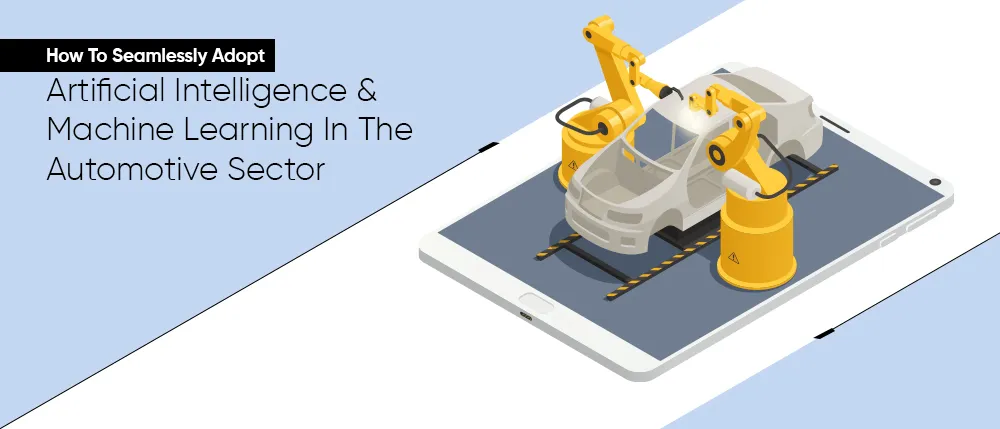
How To Seamlessly Adopt Artificial Intelligence and Machine Learning In The Automotive Sector
Don't you think the term Artificial Intelligence (AI) is sort of overused on the internet? Well, we can't blame it as AI is influencing every industry, every market segment, and every sector it touches. From recommending you a television series you are most likely to watch to predicting the onset of diseases like diabetes and even cancer, artificial intelligence is doing it all.
And the automotive industry is no exception. If you've been following our Digital Transformation In The Automotive Sector Guide series, you would know that all the market segments in the industry such as connected cars, electric vehicles, self-driving cars, and more are powered by one element – artificial intelligence.
Though we've been vaguely touching on AI aspects in our previous chapters, we are going to deep-dive into the topic and explore the real challenges in implementing AI into automotive spectrums and realize some really cool solutions this technology offers.
So, what are we waiting for?
Let's get started.
Some Important Numbers on Artificial Intelligence In The Automotive Sector
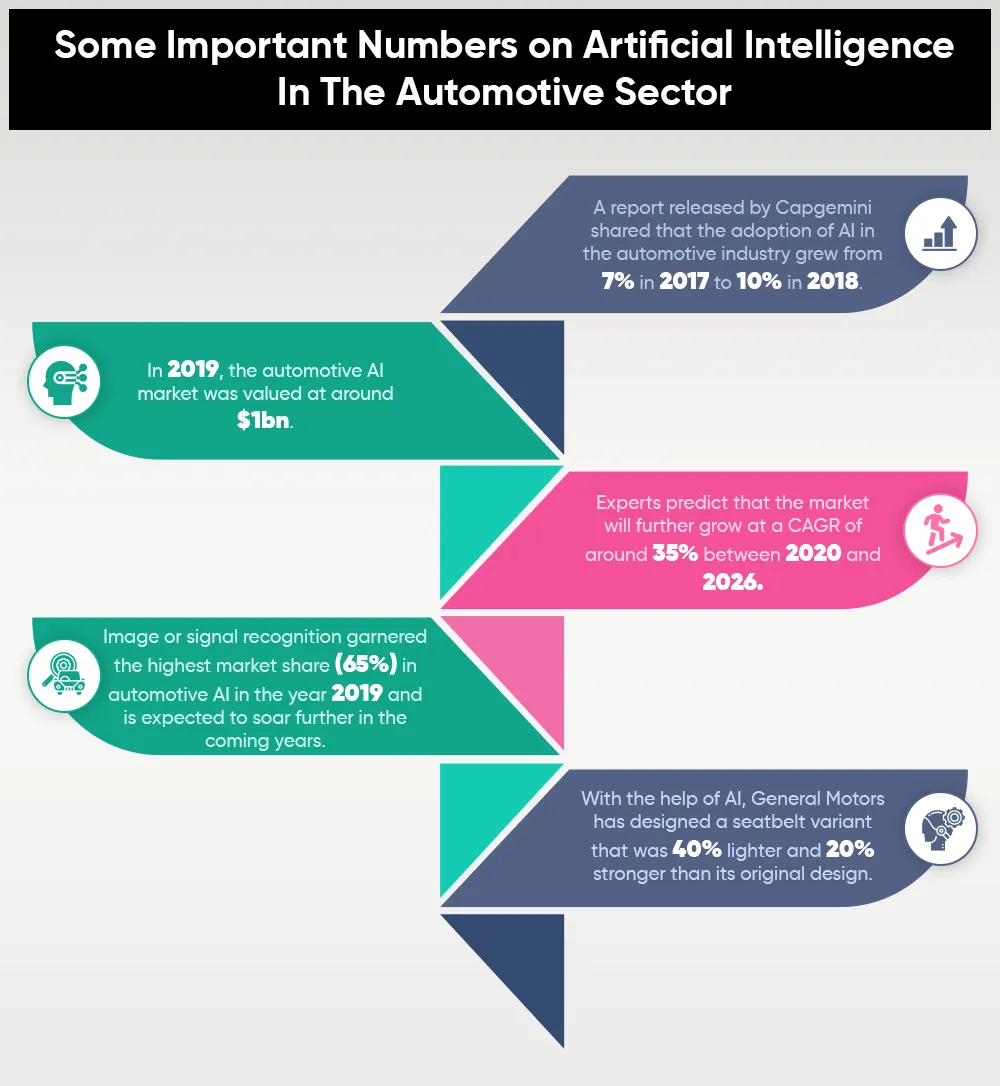
- A report released by Capgemini shared that the adoption of AI in the automotive industry grew from 7% in 2017 to 10% in 2018.
- In 2019, the automotive AI market was valued at around $1bn.
- Experts predict that the market will further grow at a CAGR of around 35% between 2020 and 2026.
- Image or signal recognition garnered the highest market share (65%) in automotive AI in the year 2019 and is expected to soar further in the coming years.
- With the help of AI, General Motors has designed a seatbelt variant that was 40% lighter and 20% stronger than its original design.
Challenges In Deploying AI In The Automotive Industry
Despite being an industry influencer and inevitable, AI offers a lot of hurdles for vehicle designers, manufacturers, and other stakeholders. In this chapter, we have identified some of the most common concerns in automotive AI integration.
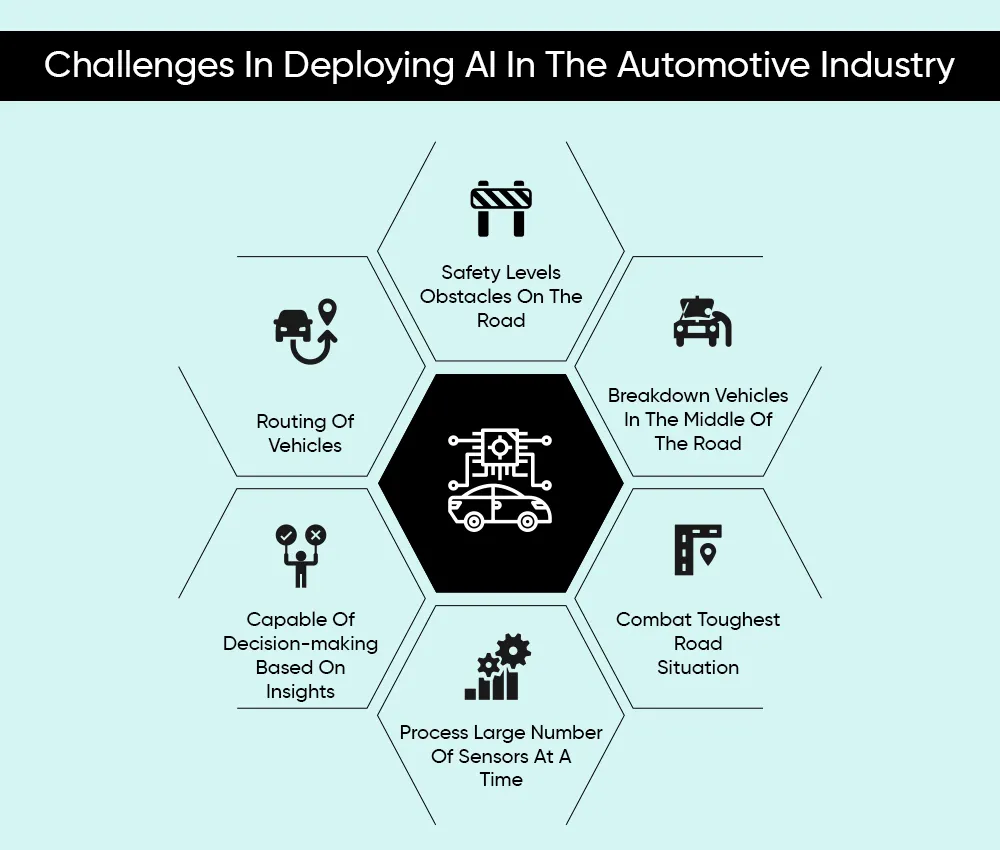
Let's look at them individually.
Safety Levels: Obstacles On The Road
As far as connected and autonomous vehicles are concerned, it is the primary responsibility of the artificial intelligence modules to take optimum and sensible driving decisions. Computer vision and embedded systems are just sensory devices that can collect data. The actual processing has to happen at the brain of the vehicle, which is the AI module. And for that, the algorithms have to be trained to precisely and swiftly perform their actions.
For instance, they should be able to quickly detect obstacles on the road such as crossing animals or pedestrians, cornering vehicles, potholes, or bad road conditions, and more and send out relevant instructions for the components to make driving decisions. If the modules fail to detect objects on the road or overlook a threat, it could cause damages to life, property, or both.
Breakdown Vehicles In The Middle Of The Road
Artificial intelligence is also responsible for predictive analytics. This means that based on historic driving data and current data, the algorithms have to predict diverse scenarios and be prepared for them all.
For instance, data on engine health has to be studied by the modules and consider parameters like last servicing, lubrication, miles are driven, and more to predict when the engine is most likely to malfunction.
This way, the system has to prevent unprecedented vehicle breakdowns. If the systems don't process this data, vehicles are compelled to be stranded in the middle of nowhere, causing concerns to passengers on board.
Combat Toughest Road Situation
We've mentioned in our previous chapters and we will do it again – roads are full of uncertainties like accidents. And a major contributor to these kinds of uncertainties is bad road conditions. From sudden potholes to dead ends and under-construction roads, cars have to traverse through them all.
Though conventional vehicles don't have an option to know or predict probable road conditions, smart vehicles with AI modules can. But again, the AI system must be trained at identifying bad road conditions and conditioned to combat them. If not, smart vehicles wouldn't be simply smart enough.
Process Large Number Of Sensors At A Time
A smart or an autonomous vehicle is made up of tons of sensors and devices. There is LIDAR, RADAR, microphones, sensory devices, and more working and generating tons of data every single second. And all these massive chunks of data are sent to the AI modules, which process everything at the same time.
From a siren sound that the car's microphone picks up from afar to an approaching pothole that a vehicle's camera recognizes, data from a myriad of sources reaches the processing unit simultaneously. A smart car is always processing data at the backend.
Capable Of Decision-making Based On Insights
All the data from diverse sources we discussed above have to be processed by the AI algorithms process for appropriate decisions at once. This demands the processing of data at the speed of milliseconds and transmission of instructions to different components at lightning speeds. The system has to mimic the human brain in these situations because if the modules fail, these cars could end up blocking the road for the ambulance behind and end up crashing on the pothole.
Routing Of Vehicles
AI algorithms also have to ensure a vehicle takes the best route possible to reach a destination. This route should be devoid of congestion or traffic, have better road conditions, and meet other driver requirements. Besides, the AI module should also predict probable weather conditions for the suggested route. And if unnecessary consequences are estimated or detected by vehicles, the AI modules should also immediately recommend better and alternate routes to ensure the drive is uninterrupted.
AI and ML Solutions For The Automotive Sector
When deployed right, artificial intelligence can work wonders for your automotive industry. As experts believe, AI is the one to drive the automotive sector forward in the coming months and years. With so much importance given, let's explore from our side the solutions AI can offer in the sector.
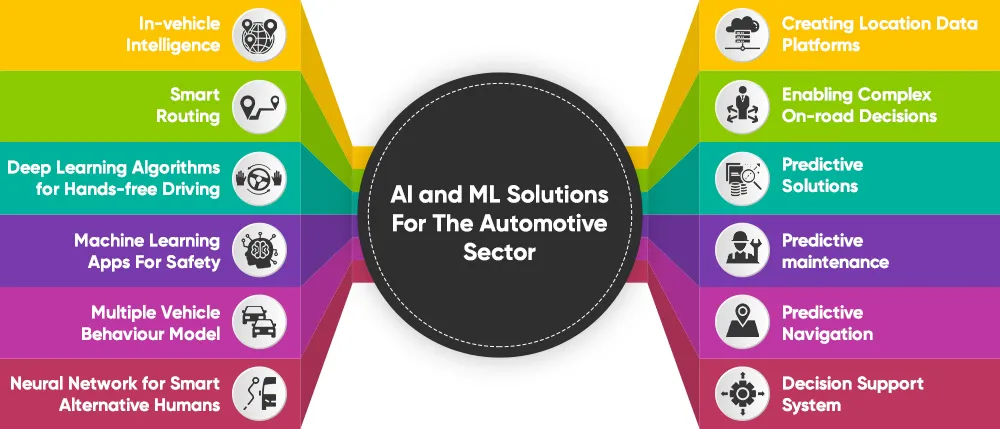
Creating Location Data Platforms
Location data refers to the data on a vehicle's precise location details. As far as vehicles are concerned, location data is generated from multiple sources such as their GPS devices, wireless connectivity networks, beacons, cell phone towers, and more.
All these data sets optimize the location details of vehicles and allow stakeholders to perform multiple actions. But all the data generated on location has to be stored internally for processing purposes. That's exactly what location data platforms do. With location data platforms, a number of location intelligence strategies could be implemented such as nearby gas stations, remote vehicle diagnostics, on-location servicing requests, and more.
Enabling Complex On-road Decisions
AI modules can make some of the most complex driving decisions instantly when they are fed and trained with tons of data sets. From public data to custom-generated data, the more samples AI modules work on, the better they become at identifying objects, conditions, scenarios, and more. And with this consistently-optimized skill, they can instantly decide whether a vehicle should slow down, change lanes, call 911, trigger car vipers, alarm passengers, or more.
Predictive Solutions
Now, predictive analytics is a broad term, which can be refined into three fragments for better understanding. Let's explore what they are:
Predictive maintenance – this is when the AI modules in operations anticipate and predict a probable component malfunction in an approaching phase of time and notify users of the same. This allows drivers or fleet owners to be cautious about the probable situation and take timely actions such as choosing a different vehicle or getting it serviced. Based on configurations and adequate AI training, automatic service requests, car components ordering from eCommerce stores or dealers and more can be done autonomously. Predictive maintenance ensures the vehicle's health is always maintained at optimum levels.
Predictive Navigation – another good application of predictive analytics is its ability to predict traffic, road, and weather conditions in a given route and share insights on the best routes to take to drivers. For instance, if a driver has to reach from Point A to B, predictive navigation will instantly analyse data on past traffic records in the specified route, data on current traffic, road conditions, weather scenarios, and more and predict if the route is ideal or not. From sharing the estimated time of the journey to suggesting ideas on other routes to take, predictive navigation will ensure there are no hiccups along the journey.
Decision Support System – all predictive analytics modules require a system that strengthens the decision taken by the algorithms. Predictive analytics is only airtight and comprehensive when it not just predicts a probable outcome but suggests appropriate decisions, actions or corrective measures. That's exactly what decision support systems do. To give you a quick example, these modules instantly suggest the best alternative route to take from one point to another upon learning that there would be a probable congestion in the previously decided route.
In-vehicle Intelligence
In-vehicle intelligence can make way for a vehicle to become more efficient and powerful. With the deployment of artificial intelligence, sensors, mechatronics and more, vehicles can be made completely autonomous and be optimized for vehicle safety, security and performance.
Smart Routing
Smart routing is another resourceful feature of AI module, where drivers can get quick alternatives to current routes when there is a sudden onset of congestion, blocked roads and other unprecedented scenarios. Instead of waiting for the conflict to solve, AI solutions can quickly suggest different routes to drivers and ensure the journey is seamless.
Deep Learning Algorithms for Hands-free Driving
One of the best advantages of possessing a high-end assisted driving car is the hands-free driving feature. While it might sound cool and be ambitious, the sheer volume of data processing that happens in the backend is surreal. A subset of artificial intelligence called deep learning is deployed for advanced algorithm training purposes. These are far more complex than superficial AI that we all are used to. With effective deep learning algorithms, cars can learn by themselves how to drive by working on data from all sources and let drivers rest for a while in the journey.
Machine Learning Apps For Safety
This refers to the implementation of advanced machine learning modules specifically conceived and developed for complex road traffic. This is powered by concepts like statistical signal processing to foster a safe environment for vehicles. With advanced vehicle tracking and intelligence, machine learning apps for safety can make roads safer and accident-free.
Multiple Vehicle Behaviour Model
Multiple vehicle behaviour is all about deploying a machine learning model, where the behavioural changes of multiple vehicles are tracked and processed. An action of a connected car in vicinity triggers a series of consequences and this ripple effect can be seamlessly studied with the help of this model. With more vehicles tracking each other's changes and accommodating them with their own decisions, human intervention will be gradually reduced to zero.
Neural Network for Smart Alternative Humans
For the uninitiated, neural network refers to the digital version of the human neural network that stores and transmits information of the past and consistently makes use of it to make current decisions. As far as automobiles are concerned, neural networks can immensely benefit autonomous vehicles by helping them learn from datasets and optimize their training without necessarily having to go through a specific scenario to learn.
For instance, an autonomous vehicle about to traverse through ice can make use of the information in neural networks to ensure it cruises slowly and has relevant braking mechanisms applied. And the best part is that this can happen even without the vehicle having to drive on ice in the first place.
Case Study
One of the biggest challenges with respect to autonomous vehicles lies in accurately predicting the time a vehicle would cut in or the time a pedestrian would cross the road when our vehicle is approaching. If you notice, it is during instances like these that human instincts kick in and we as drivers would do the needful by either stopping and giving way or braking.
But for vehicles with no drivers, what would be the actions and consequences?
Well, this is exactly what the California-based autonomous car development company called Cruise is working on.
It works on algorithms and modules that prepare vehicles for both adverse and general conditions. But for that, the vehicles have to get trained on both to differentiate what can be classified as adverse and what can be called general road situations. According to Cruise, the major challenge lies in developing an autonomous system that not only does handle general situations well but tackles uncommon conditions precisely and swiftly as well.
For this, it is working on training its AI modules with data modified for learning purposes. It uses techniques like failure mining and perception stacks to bring in minimal human intervention in decision-making scenarios. It's deployment of Continuous Learning Machine helps the system consistently monitor and learn from its surroundings and the behaviour of other cars to keep its datasets optimized at all times.
And when unforeseen scenarios actually happen, the system makes a decision based on its learnings.
The Future of Automotive AI
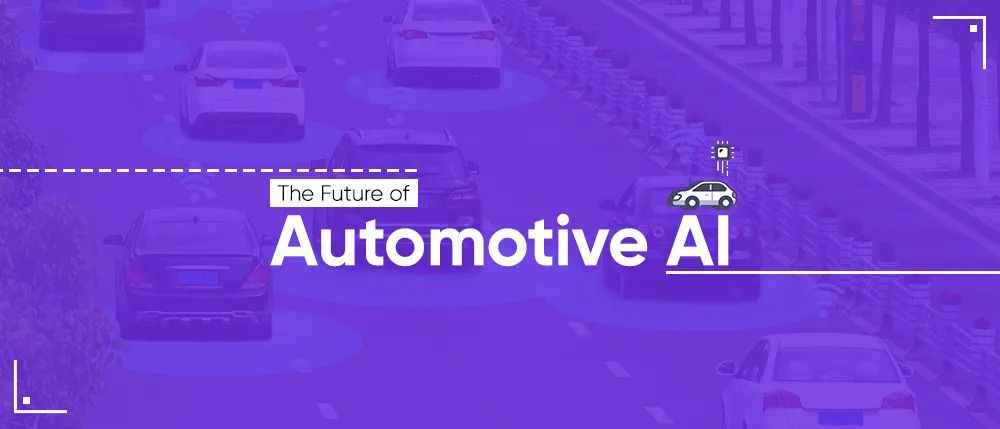
As far as the automotive industry is concerned, one thing experts, tech enthusiasts, and manufacturers agree on is the dynamic rise of autonomous vehicles in the coming years. What is prevalent only in select states in the US will soon be prominent in other countries as well. From our observation, we believe the future of AI will be responsible for making Level 3 and Level 4 autonomous vehicles a reality on our roads and that the masses can soon go driverless.
Apart from this ambitious dream, we also look at automotive AI to offer experiences beyond infotainment. This means the modules will evolve to learn more about their drivers and create an in-car environment, mood, and ambiance that is based on their prevailing moods and mindsets.
For instance, from car temperature and fragrance to recommended music choices, AI systems will take care of them all and bridge the gap between machine and human bonding. Instances like these will also give life to vehicles in one way.
And we had discussed in the previous chapters, AI modules will also evolve in scale and processing capabilities because they have to keep up with the data generation demands that come with the rise of 5G technology.
Besides, AI will also work on understanding customer behaviour and help manufacturers come up with unique marketing strategies, simulate campaign ideas, find out the best possible ways to reach out to customers, target them and even personalize cars based on their needs.
Wrapping Up
So, what do you think? AI is the way forward for humanity, right? It definitely is and there's nothing to be paranoid about. No matter what experts believe, machines will always require human intervention and supervision. It's all about getting a head start.
And if you're exactly looking for that head start for your AI venture for the automotive sector, we suggest you get in touch with your application and implementation ideas. We will develop the best automotive solutions for your business that will be future-proof in the automotive space.
Reach out to us today.